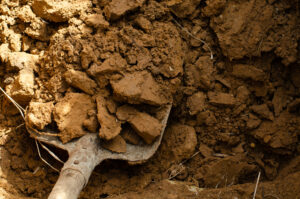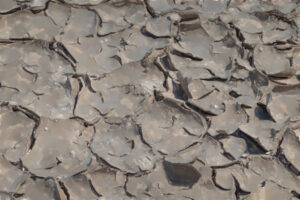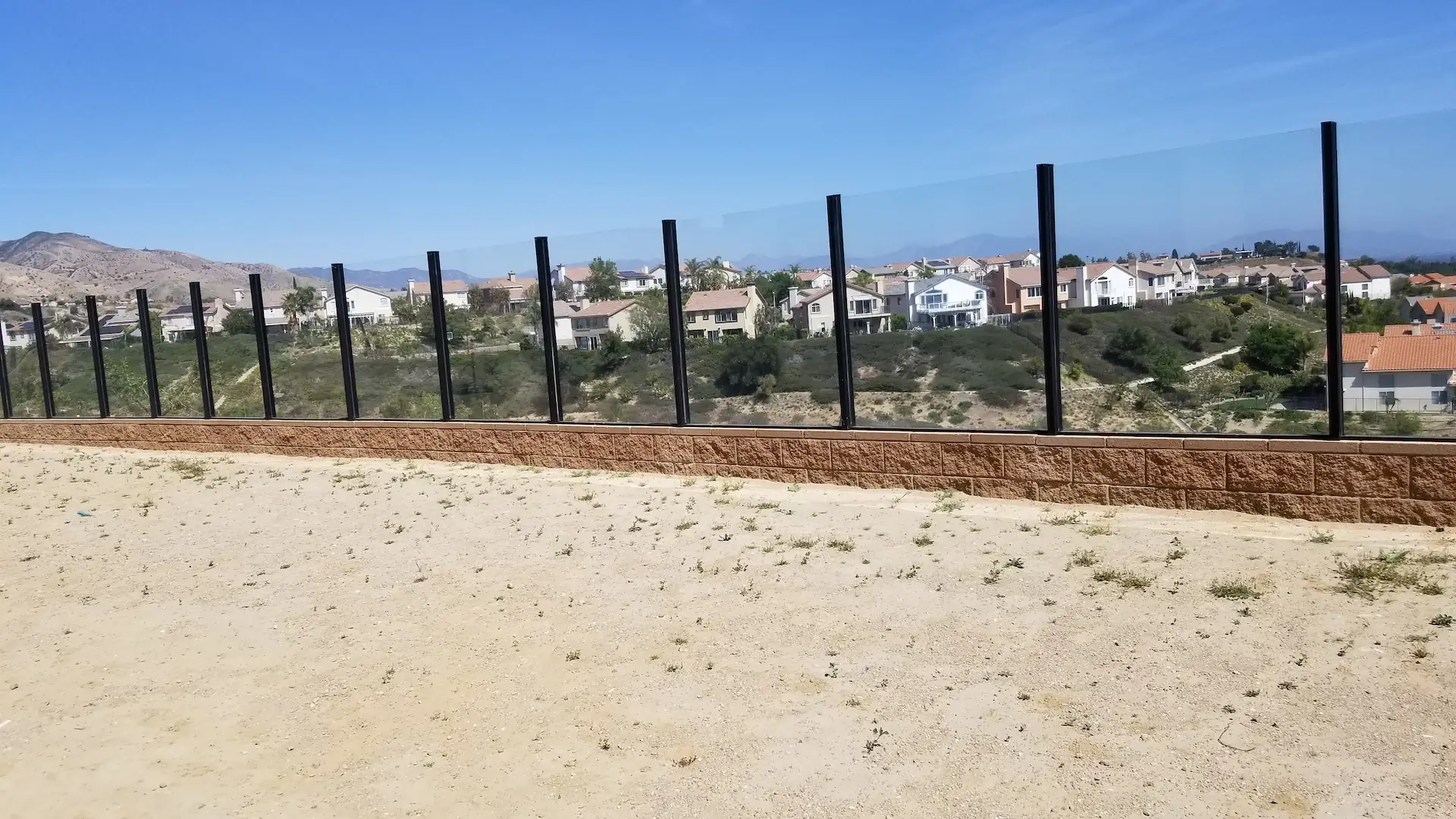When it comes to construction projects, the type of soil on which they are built plays a significant role in their long-term stability. Clay soils, in particular, exhibit a unique characteristic: they shrink and expand based on changes in moisture content. This article aims to shed light on the behavior of clay soils, specifically addressing how they shrink during droughts and expand when exposed to regular irrigation and rainfall. With a focus on patio and hardscape construction, we will explore the challenges associated with building on clay soils and potential strategies to mitigate their effects.
Understanding Clay Soils

Clay soils are composed of fine particles that have the ability to retain moisture. This moisture retention capacity gives clay its characteristic plasticity and malleability. However, it also makes clay highly responsive to changes in moisture content, resulting in shrinkage and expansion.
Shrinkage During Drought

In periods of prolonged drought, the moisture content in clay soils diminishes significantly. As a consequence, the clay particles lose their ability to hold water, causing the soil to shrink. This shrinkage can be particularly noticeable in the top 3-4 feet of soil, known as the “active zone”. During dry spells, the active zone can contract by several inches, leading to subsidence and potential structural damage to patios and hardscapes built on the affected soil. Think of a kitchen sponge left on the sink overnight. In the morning it shrinks in size, but water will cause it to expand back to normal size. The same thing occurs in the active zone of clay soils.
Expansion During Rainfall

Conversely, when clay soils are exposed to regular rainfall or irrigation, they absorb water and undergo expansion. The clay particles attract and retain moisture, causing them to swell. This expansion can result in significant upward pressure on structures such as patios and hardscapes, potentially leading to heave cracking, tilting, or even complete failure.
Challenges in Patio Construction on Clay Soils
Building patios and hardscapes on clay soils presents several challenges due to their shrinkage and expansion properties. Failure to address these challenges adequately can result in costly repairs or reconstruction. Some key issues include:
- Cracking and Settlement: Shrinkage during droughts can cause the soil beneath patios to settle, leading to cracks in the structure. Similarly, expansion during wet periods can exert pressure and cause heaving, resulting in uneven surfaces.
- Drainage Problems: Clay soils have poor drainage characteristics, leading to water pooling and potential damage to the patio’s foundation. Improper water management can exacerbate the effects of clay soil expansion.
- Soil Erosion: In periods of heavy rainfall, clay soils can erode due to the increased water content. This erosion can undermine the stability of patios and hardscapes, compromising their structural integrity.

Mitigation Strategies
While building on clay soils presents challenges, there are strategies to mitigate the risks associated with shrinkage and expansion:
- Site Evaluation: Conduct a thorough evaluation of the soil conditions prior to construction. This assessment can help determine the extent of shrinkage and expansion expected, allowing for appropriate design and engineering considerations.
- Soil Stabilization and moisture conditioning: Landscaped areas around house foundations, hardscape patios and planters need to be maintained uniformly wet all year long. Changes in moisture cause significant changes in the volume of the soil.
- Proper Drainage: Install adequate drainage systems to prevent water accumulation and promote proper water flow away from the patio or hardscape. This can help alleviate the pressure exerted by expanding clay soils.
- Structural Design: Consider flexible construction methods and materials that can accommodate the potential movement of the clay soil. This may involve incorporating expansion joints or using flexible materials that can withstand soil expansion and contraction. Garden walls and structures should be isolated with cold or control joints to allow for movement and maintenance/repair over time.
Clay Soils and Patios
Understanding Patio Movement on Clay Soils: Drought and Extreme Rainfall Effects
As a homeowner residing on clay soils with expansion potential, it is important to recognize how the combination of long periods of drought followed by extreme rainfall can impact your patio. The unique characteristics of clay soils make them highly susceptible to movement during these weather fluctuations. Here’s an explanation of how drought and extreme rainfall can cause patio movement on clay soils:
Drought Effects

During prolonged droughts, the moisture content in clay soils decreases significantly. Clay soils have a remarkable ability to shrink when moisture is scarce. As the soil loses water, the clay particles compact, leading to shrinkage and subsidence.
- Shrinkage and Settlement: As the clay soil shrinks, it can cause the ground beneath your patio to settle unevenly. This settlement can result in cracks, tilting, or even sinking of the patio structure. The extent of the shrinkage and subsequent settlement can vary based on the severity and duration of the drought period.
- Soil Desiccation: Clay soils in drought conditions become excessively dry and may develop cracks. These cracks create pathways for water infiltration during subsequent rainfall events. The desiccated soil is more susceptible to rapid water absorption, which can exacerbate the potential for movement during subsequent heavy rainfall.
Extreme Rainfall Effects
When clay soils experience extreme rainfall after a prolonged drought, they undergo a significant change. Clay soils have a high capacity to absorb water, leading to expansion and swelling.
- Soil Expansion: As clay soils absorb moisture from heavy rainfall, they expand due to the increased water content. This expansion can exert pressure on the foundation of your patio, causing it to shift, crack, or heave.
- Differential Movement: Differential movement occurs when different areas of the soil expand at different rates. This can cause uneven stresses and movement beneath the patio, resulting in an uneven surface, cracks, or even the complete displacement of the patio structure.
The Combination Effect
The combination of drought-induced shrinkage followed by extreme rainfall-induced expansion creates a cyclical pattern that further exacerbates the potential for patio movement on clay soils.
- Stress and Strain: The repeated cycles of shrinkage and expansion put significant stress and strain on the patio foundation and structure. This constant movement can lead to increased wear and tear, compromising the stability and integrity of the patio.
- Soil Saturation: During extreme rainfall events, the sudden saturation of clay soils can also lead to a loss of strength and reduced load-bearing capacity. This can further contribute to patio movement and potential structural damage.
Understanding the interplay between drought and extreme rainfall on clay soils is crucial for homeowners with patios. By recognizing the potential for shrinkage during droughts and subsequent expansion during heavy rainfall, you can take proactive measures to minimize patio movement and maintain the long-term stability of your outdoor space by maintaining moisture in the soil year-round.





